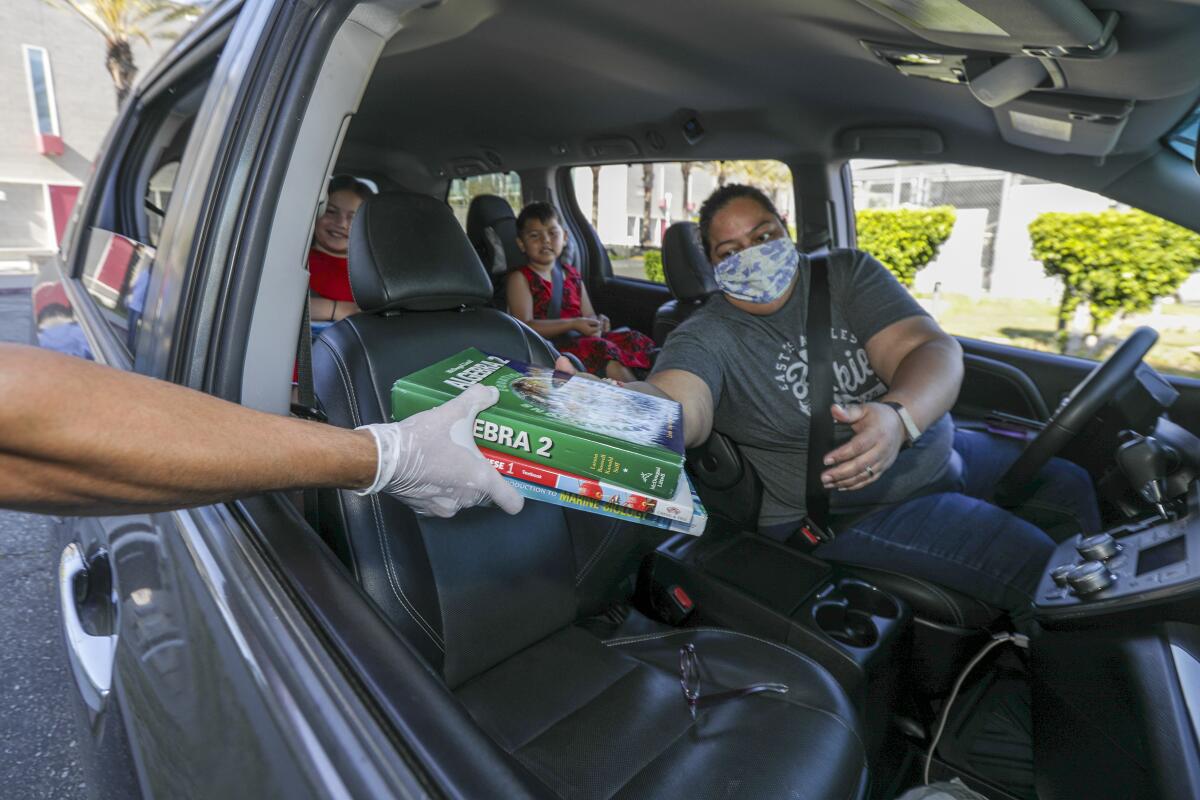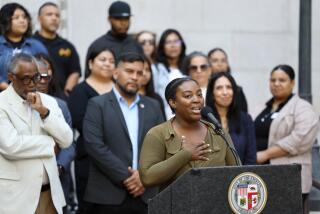Working parents face a child-care crisis. Here’s how L.A. employers are handling it

- Share via
The scramble began in March. Offices shut down, then schools and day-care centers.
Parents who could work from home struggled to stay productive while keeping toddlers entertained and teens focused on remote schoolwork. Those deemed essential workers somehow had to find someone to watch their kids while they spent their days in newly dangerous workplaces.
We just have to make it through the lockdown, they told each other. Then: We just have to make it through the summer.
Forced to adapt to this new normal, California’s biggest employers responded, in varying degrees, with measures such as paid leave for caregivers, flexible work schedules and stipends for child care. But now that the L.A. Unified School District and many others across the state are barred from opening for in-person classes in the fall, many of those employers are still relying on emergency policies intended as short-term, stopgap measures, while some are even cutting back on new child-care benefits.
That leaves working parents like Amy facing a daily crisis that’s both increasingly urgent and depressingly familiar.
A single mother of three who has worked at a Rite Aid in the Valley for nearly a decade, Amy has been on leave since March, relying on healthcare coverage through her union, unemployment benefits and federal stimulus cash, all of which could soon run out.
“To be honest, I don’t really have a rigid plan,” said Amy, who asked to not be identified with her last name as she is not authorized to speak for her employer. “I’m taking it day by day, week by week.”
When the COVID-19 pandemic began, she chose to stay home to take care of her kids instead of going to work.
Her oldest was struggling to follow classwork on his laptop. Her mother could watch her younger sons after their day care shut down, but Amy knew that any shift on the pharmacy floor would increase her chances of bringing the coronavirus home, and she feared her mother wouldn’t survive an infection.
When the case count started ticking up and schools started closing, her union, the L.A. local of the United Food and Commercial Workers, negotiated an emergency deal with the companies that run Rite Aid, Albertsons, Ralphs, Vons and the rest of the grocery and pharmacy stores where more than 20,000 of Local 770’s members work.
The deal allowed workers to take an indefinite personal leave of absence but keep their health benefits. A change in state law made it so Amy could also collect unemployment insurance during her leave at home, which was boosted by the $600-a-week federal CARES Act stimulus.
At the time, said Kathy Finn, UFCW Local 770’s secretary-treasurer, the leave and benefits policy seemed like an afterthought compared with issues of worker safety and hazard pay. But it has proved a lifesaver for parents like Amy.
Four months later, Amy is still at home, watching the case count rise and preparing for another semester of at-home learning from LAUSD for her son. Unless the union can negotiate an extension to the health benefit policy, she’ll be kicked off the plan in August. And without the $600 weekly supplement, normal unemployment insurance won’t go far.
Amy is not alone. Many state- and employer-provided benefits are slated to expire over the summer, even though child-care needs have not changed.
Nationally, fewer than half the U.S. companies that have returned to in-person work have a plan for employees with child-care responsibilities, and only 32% of companies that have announced a set date for returning to work have come up with a plan, according to recent research from the Society for Human Resource Management.
But employers may be forced to figure something out soon, as the reality of rising cases and remote schooling sets in for working parents across the country, said Rachael McCann, a senior director at the human resources consulting firm Willis Towers Watson.
“The changes we’ve all seen have led to shock, dismay and anger, but I think companies are about to move into acceptance,” McCann said. “We actually have to be dealing with this for the next 12 months; there’s no more denying that a pandemic is here.”
Research from Willis Towers Watson found that before March, companies were offering some parental support, but it varied widely from sector to sector. Financial services companies were the most likely to offer child-care benefits and led the pack in subsidizing employees who paid for off-site child care, while healthcare companies were the most likely to offer on-site subsidized child care.
Back then, these kinds of child-care services were “a nice-to-have, but utilization was incredibly low — employees often didn’t even know they had it,” McCann said.
Six months into the pandemic, McCann said, priorities have changed: “It’s shifted from being viewed as a perk to being a critical need.”
That need has been clear for healthcare workers and companies since the pandemic struck. Three of L.A.’s top 10 private-sector employers are healthcare companies, with more than 70,000 workers between them, and the essential workforce includes a higher proportion of parents and more women, who are often stuck shouldering child-care responsibilities, than the working population as a whole.
Kaiser Permanente, L.A.’s largest private-sector employer, with more than 40,000 workers, in early April took the step of offering $300 per week to pay for child care; the money could be used to pay a child-care center or could go directly to a relative or friend.
But Steve Trossman, director of public affairs at SEIU-UHW, the union that represents 55,000 workers at Kaiser Permanente across the state, noted that the program was halted June 14, at the end of the school year.
“The unions are urging Kaiser to reinstate this benefit now that it is clear that most schools will not open for in-person classes,” Trossman said in an email.
Kaiser declined to provide details on the other benefits it has offered to working parents during the pandemic but noted in a statement that “the initial child-care support program was temporary in nature,” adding that the organization is “exploring other options that are more sustainable to assist employees with child-care challenges, including leveraging remote work for those employees where it is feasible and productive.”
Cedars-Sinai, which employs nearly 15,000 people in the county, has offered direct payments for child care over the course of the pandemic.
“Once COVID hit, we had to shift gears very quickly,” said Andy Ortiz, senior vice president of human resources at Cedars-Sinai. The organization allowed employees who could work remotely to do so, enabled more flexible scheduling and offered a child-care payment of $100 per day for workers whose jobs required them to interact with patients.
The freeze on nonessential medical care meant that many Cedars employees had no work to do, but rather than opt for furloughs or layoffs, the medical center decided to keep paying them a full salary through the lockdowns.
Once more information about the new coronavirus was available and the hospital hit a more regular crisis cadence, Ortiz said, it reduced the subsidy to $40 per shift, capped at 10 shifts per month. Employees working from home were left to their own devices, but Ortiz said the organization had to make some tough decisions to prioritize the needs of frontline employees.
It’s unclear how the level of parental support will change in the fall, Ortiz said, but he noted that Cedars and a number of other healthcare systems are meeting to discuss what to do next.
“That’s something we’ve been planning for and trying to figure out,” Ortiz said. “Some school districts start as early as three weeks from now. We know there’s a heightened level of anxiety.”
Prior to March, Cedars employees had access to backup care through Bright Horizons, a Massachusetts company that has a network of more than 3,500 child-care centers.
The Providence health system, which employs 16,000 people in L.A. County, offered 10 days of Bright Horizons backup care for the first time this year, said Maracie Wilson, the system’s director of employee well-being. Typically, the backup care system tries to place children in nearby day-care centers or bring in available in-home care, but it will give employees $100 to pay a friend or relative as a last resort. During the height of the crisis, however, when day-care centers closed and the risk of infection for in-home care rose, the $100 payment was offered as a first option.
“We thought it would be a sleepy little program that didn’t get a lot of utilization, and suddenly it became the No. 1 benefit that we were working on supporting during this crisis,” Wilson said.
Marisa Lester, an executive assistant at Providence Cedars-Sinai Tarzana Medical Center who is unable to work remotely, has three children who attend the Conejo Valley Unified School District.
She took advantage of the benefit in the spring to have her mother guide her sons, ages 16 and 13, and her daughter, 11, in home study. She preferred not to bring in a non-family member so as to minimize the risk of anyone contracting the virus.
“That was really big for me,” said the 35-year-old Simi Valley resident.
Providing paid child care to every worker who is a parent to young children would be financially unsustainable for Providence, Wilson said, though the system does offer discounted child care through Bright Horizons and provided an additional 10 days of backup care benefits beginning in July. The hospital system estimates that 10% of its 116,000 employees in the seven states in which it operates have needed child-care support since the coronavirus lockdowns began.
Bright Horizons has proved popular among large employers in L.A. NBCUniversal, with 12,000 employees in the region, provides discounted rates for child care through Bright Horizons and paid caregiver days off, though the company declined to provide details on the discounted rates or number of days offered.
Target, which employs 15,000 in the county, has offered an emergency backup care benefit to all its employees since April, providing an unlimited number of free days of emergency child care through Bright Horizons if an employee’s regular care is disrupted. The benefit is set to expire at the end of August, however, and Target declined to comment on whether it might be extended into the fall.
(Three of L.A.’s top employers declined to comment for this article: security company Allied Universal, with nearly 13,000 employees in the county; Walt Disney Co., with 13,000; and defense contractor Northrop Grumman, with 18,000.)
Some employers face fewer budgetary concerns. Bank of America, with 7,500 L.A. County employees and trillions in assets, expanded and enhanced its Bright Horizons backup child-care benefit once the pandemic hit and its employees began working at home. The enhanced benefit allows employees to receive up to $100 a day for a provider of their choice, with friends and relatives eligible. The bank spent about $93 million on the benefit for 20,000 workers from March through June 30, a spokesperson said.
David Masias, a 31-year-old financial advisor at the bank’s Merrill wealth management division, said the backup care was helpful for him and his wife, an executive assistant, as they worked remotely. The couple have a 12-year-old daughter who attends school in the Glendale Unified School District, which shifted to distance learning in March and will resume that next month.
“We have been able to bring in outside help to keep her on track during the day,” said Masias, whose Spanish-speaking mother-in-law is assisting his daughter, who is enrolled in a dual-language immersion program. “That has made a huge difference keeping her on track. You definitely see a difference between our experience and a lot of other children and parents that I have been talking to over the last couple of months.”
The backup care benefit provided workers with 40 days of care at the start of the year, which the bank later boosted by 10 additional “family care” days. The enhanced cash benefit is set to end Aug. 15. The bank is assessing what to do next.
Masias and his wife are taking no chances and have been cutting back on expenses, socking away money to continue paying his mother-in-law when school resumes. “We are hoping to continue what we’ve been doing,” he said.
Times staff writer Laurence Darmiento contributed to this report.
More to Read
Inside the business of entertainment
The Wide Shot brings you news, analysis and insights on everything from streaming wars to production — and what it all means for the future.
You may occasionally receive promotional content from the Los Angeles Times.











